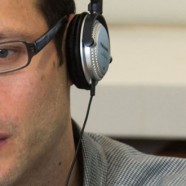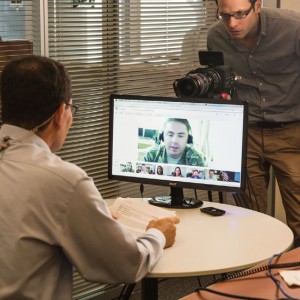
When Jason Spingarn-Koff ’92 headed for Brown University after Milton, he thought he would get involved in storytelling somehow, and perhaps in medicine. “So maybe I’d become a doctor who writes plays,” Jason laughs in hindsight. “I wanted to integrate my creative side with caring about the world,” Jason says. “I wanted to make an impact.”
He did pursue filmmaking, science and journalism. A video journalist and filmmaker, Jason directed the feature-length documentary Life 2.0, about people consumed by a virtual world, which premiered at the 2010 Sundance Film Festival and was acquired by OWN: The Oprah Winfrey Network. Following a Knight Science Journalism fellowship at MIT, the New York Times hired him in 2011 as the first-ever video journalist for the Opinion section.
Jason’s challenge and thrill is to help the Times writers and editors break new ground in creating a video analog of the traditional op-ed page. How can new media engage the Times’ nearly two million daily readers?
The site’s unique video series, Op-Docs, is one venture that has sparked a potent response. Jason produces and curates Op-Docs, which was launched in November 2011. A “forum for short, opinionated documentaries,” the Times says, Op-Docs is “produced with wide creative latitude and a range of artistic styles, covering current affairs, contemporary life and historical subjects.”
Several new Op-Docs appear in the Opinion section each month. Often their creators are prize-winning documentary filmmakers. Emerging artists also appear, as does the work of video journalists on the scene of breaking news.
Can these powerful video opinions launch civil discussions among strangers? The series’ track record is as interesting as it is impressive.
The Op-Doc called “Dismantling Detroit” draws us—for five compelling minutes—into the desperate nighttime work of scavenging scrap metal from Detroit’s dismantled buildings. The young men who ferret out and sell the metal to eager global buyers are trying to survive Detroit’s destiny, to support themselves in an uncompromisingly bleak landscape. Readers’ reactions are stunningly thoughtful: They pose questions about the future of our cities; they argue about globalization; they show a historical context for making money from detritus. The online commenters explain their reasoning, follow up on one another’s remarks, and suggest different ways of looking at things. A person’s quick decision to click “view” can turn into a much fuller, shared consideration of diffi cult issues.
 In the same time window, we can witness the full, raw scope of “Waiting for Health Care” in the emergency room of Highland Hospital in Oakland, California. Sights, sounds and human situations are as relentless as the flow of people in this video. We feel something of the hours’ long wait that is routine for hundreds of uninsured or low-income people, whether or not their needs are acute and serious. Lost work time and mounting pain are almost palpable. We’re amazed by dedicated staff managing an overwhelming scene. Providers move from rescuing trauma victims to administering patients—the majority—with straightforward, non-acute care.
In the same time window, we can witness the full, raw scope of “Waiting for Health Care” in the emergency room of Highland Hospital in Oakland, California. Sights, sounds and human situations are as relentless as the flow of people in this video. We feel something of the hours’ long wait that is routine for hundreds of uninsured or low-income people, whether or not their needs are acute and serious. Lost work time and mounting pain are almost palpable. We’re amazed by dedicated staff managing an overwhelming scene. Providers move from rescuing trauma victims to administering patients—the majority—with straightforward, non-acute care.
Readers bring the fire and emotion of the health-care issue to their commentary on this piece. They share dire personal histories that drive them to certain conclusions. They explain and question; they compare, contrast and argue—about health care in Europe, the “real” cause of our national problem, or the roles that different stakeholders play. Providers offer insight drawn from their life labors. Some responders are short on patience; others urge compassion and responsibility.
If energy in the exchange is any measure, this discussion taps a need. Readers even seem to set the bar for what a national conversation should be—if we had one. They declare a range: this should be on the table; that should be off the table.
For many people who join in these online discussions, their politicians have failed them. Readers make it clear that simplifi cation of the issue won’t work and doesn’t satisfy anyone. For instance, one writes: “No matter the outcome of the Supreme Court’s decision on the individual mandate to buy health insurance, the Affordable Care Act remains flawed because it will leave at least 26 million people uninsured and does nothing to reduce health-care costs.” Another writes: “It annoys me every time I hear or read that ‘Medicare for all can’t be done.’ This attitude persists although the great majority of Americans approve of Medicare, and many of those who are ‘against Obamacare’ are against it because it isn’t as good as Medicare.”
Readers also seem upset with predictable ideology, from all points on the political spectrum. “Conservatives seem to believe that if you’re sick, you brought it on yourself,” one person writes. “If you’re poor, you don’t work hard enough; if you can’t afford to see a doctor or buy medicine, you should do what Grandma did and drink alfalfa tea until you’re well again. They don’t see any evidence that illness often strikes without any obvious reason (even nonsmokers get lung cancer), there aren’t enough jobs that can pull families out of poverty, and medical costs in the modern world are simply beyond the reach of anyone who isn’t a Wall Street CEO or a Powerball winner. And yet they think of themselves as ‘realists.’”
These commenters read each other’s posts and respond point for point. The Op-Docs commentary lives and moves in different ways on multiple platforms, such as Twitter, Facebook, YouTube, Google+, and New York Times blogs. According to Jason, the backand-forth generated by some pieces sustains itself for weeks.
Traditional documentaries aren’t the only videos that stimulate conversation. Jason has been “working to create an outlet that’s diverse in subject matter but also style,” he said in an interview with Indiewire.com. “It has a distinct feel from most news. Here we’re working with indie filmmakers, animators, artists to create films that can spark dialogue around topical and historical subjects.”
Readers are surprised, Jason thinks, to find snappy satire on the site. “Satire is a contemporary take on opinion,” he explains, “and one of the top forms for cultural commentary today. This is part of the language young people are speaking.”
“Mitt Likes Music,” by the Gregory Brothers, is a musical video satire that threads together what Mitt Romney “likes” from video clips of many campaign stump speeches. The Gregory Brothers’ production became a favorite among visitors to nytimes.com.
“The piece overlaps entertainment and newsworthiness” Jason says. Catching this kind of video on a newspaper opinion page is novel. Jason and his team made sure that every line in the mash-up was authentic; an annotated lyrics list allows any viewer to find the source of each quote.
Op-Docs’ content offers a fresh take on cultural commentary in general. Casey Neistat’s films wryly remark on urban lives with “Texting While Walking,” “Bike Thief” and “Taxi Lost and Found.” Filmmaker Zina Saro-Wiwa explores the movement among black women toward “natural hair” in her film “Transition.” Her work triggered hundreds of posts from diverse women and discussions that span age, class, self-acceptance, history, emotions, and the political ramifications for women of their body shapes and hairstyles.
Often, people speak directly about finally feeling that they are part of a conversation, like this viewer: “I’m glad this is showing up in the New York Times because I was just about to lose faith in your renegade promise. I hope you continue to be open and creative this way.”
More recently, Jason’s work at the Times to promote public dialogue has expanded from documentaries to ambitious experiments in live “social video.” Last May, visitors to nytimes.com from around the world watched a live video chat between U.S. Ambassador Susan Rice, columnist Nicholas Kristof, and fi ve members of the public—unscripted and unedited. A soldier in Afghanistan was one participant asking the ambassador his own questions. Joining him on the Google+ Hangout was a high school junior from Miami, a young lawyer from New York, a physicist from Montreal and a graduate student from Ashland, Oregon.
These panelists had responded to an invitation posted on the Opinion site and throughout social media. The editors chose the five finalists from hundreds of responses.
The viewer’s screen shows the panelists, moderator and ambassador on the Google+ Hangout together. The current speaker’s image appears larger than the others, and images shift as the speakers change. “The bold thing,” Jason says, “is that we put this on live, in a prime spot—the homepage—and it went off without glitches.” To execute this project, Jason collaborated with a Web editor, social media editor, and several Google specialists.
“I think people were surprised and appreciative of the gesture that the New York Times carried out—inviting the public in for an extensive conversation on foreign policy with our U.N. ambassador and a renowned op-ed columnist,” Jason says. He and his colleagues produced a series of Google+ Hangouts with voters spanning the national party conventions this summer.
“I much enjoyed the session and encourage you and the NYT to do more! How do I find out when the next one will be?” says a viewer from Alberta, Canada.
“The high school student had very good questions. She will go places. We need panels like this to clarify so many global situations we are facing in this day and age. Good job!” says another, from New Mexico.
A viewer from Pennsylvania sums up the effect: “Thanks, Nick, for continuing to bring this “constituency of the connected” to our door. Through these ongoing conversations and dialogues via social media, we all can remain a part of an open and free democracy—a superior forum. Cheers!”
An ever-curious person, Jason has relished how video journalism and documentary filmmaking “gets you into situations most people don’t encounter.
“This is a great setting,” he says about the New York Times. “Everyone brings different experience and skills, and we all feel passionately about what we’d like to achieve. Writing, fi lming, editing, publishing, provoking debate and discussion—that’s all part of the job. That’s what we spend our energy doing, and it’s a real privilege.”
–Cathleen D. Everett
Jason directed the feature documentary Life 2.0, which premiered at the 2010 Sundance Film Festival and was acquired by OWN: Oprah Winfrey Network’s Documentary Club. Jason’s films and journalism have appeared on PBS, BBC, MSNBC, Time.com and Wired News. He was a 2010–2011 MIT Knight Science Journalism Fellow and is a graduate of Brown University and the UC Berkeley Graduate School of Journalism.



